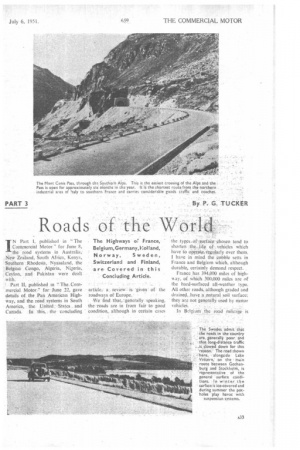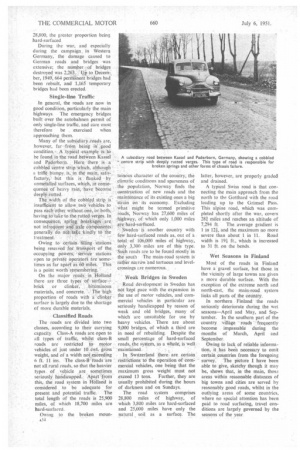I N Part I, published in "The Commercial Motor S' for
Page 47

Page 48

If you've noticed an error in this article please click here to report it so we can fix it.
June 8, the road systems in Australia, New Zealand, South Africa, Keny.s, Southern -Rhodesia, Nyasaland, the Belgian Congo, Algeria, Nigeria Ceylon, and Pakistan were dealt
with. .
Part II, published in t` The,Com.mercial Motor-' for June .22, gave details of the .Pan 'American HighWay, and the road systems in South America, the United; States, and Canada. In 'this,.. the. -concluding article; .a_ review is 'given of the roadways of Europe.:
. We find ihat,r7generally . speaking, the roads are in from fair to good Condition, although in certain cases
the -types of spriai.:e chosen tend to shorten the life of vehicles which have to opetate,Tegularly over them. I have in mind the cobble setts in France and Belgium which, although durable, certainly demand respect.
France has 394,090 miles of highway, of Which 300,000 miles are nf the hard-surfaced all-weather type. All other roads, although graded and drained,. have a natural .soil surface; they are not generally used by motor
vehicles. • In Belgium the road mileage• is 28,800, the greater proportion being hard-surfaced..
During the war, and especially during the campaign, in Western Germany, the damage caused to German roads and bridges was extensive; the number of bridges destroyed was 2,263. Up to Decem-, her, 1949, 664 pertiiiinent bridges had been rebuilt, and 1,165 temporary bridges had been erected.
Single-line Traffic In general, the roads are now in good condition, particularly the main highways. The emergency bridges built over the autobahnen permit of only single-line traffic, and care must therefore be exercised when approaching them.
Many of the subsidiary .roads are, however, far 'from being in good condition.-A .typical example is to be found, in .the road between Kassel and Paderborn. Here there is a cobbled .centre strip which, although a trifle bumpy is, in the main, satis-. factory; but this is . flanked • by unmetalled surfaces, which, in consequence of• heavy rain, have become deeply rutted.
The width of the cobbled strip is • insufficient to allow two vehicles to pass each other without one, or both, having to. take /o the rutted verges. In consequence, spring breakages are not infrequent and axle components generally -do not take -kindly to the treatment.
Owing to certain filling stations being reset ved for traii-sport of the. occupying powers. service stations open to private operators are sometimes as far apart' as 60 miles. This is a point worth remembering: On the major roads. in Holland there are three types. of surface
brick or clinker', • bituminous
materials, and concrete. The .high proportion of roads with a 'clinker surface is largely due to the shortage of more durable materials.
Classified Roads The roads are divided into two classes, according to their carrying capacity Class-A roads are open to all types of traffic, whilst class-B roads are restricted to motor vehicles of just under 10 cwl grass weight, and of a width not exceeding 6 ft. 11 ins. The class-Broads are not all rural roads, so that the heavier types. of vehicle are sometimes seriously handicapped. Apart from this, the road system in H011and is considered to be adequate for
present and potential traffic. The total length of the roads is 25,900 miles, of which 18,700 miles are hard-surfaced.
Owing to the broken mounA.34
tairKius character of the country, the climafic conditions and sparseness of the population, Norway finds the constrriction of new roads and the
maintenance of its existing ones a big _ strain on its economy. Excluding what might be termed primitive roads, Norway has 27,600 miles of highway, of which only 1,000 miles are hard-surfaced.
Sweden is another country with few hard-surfaced roads as, out of a total. of 106,000 miles of highway, only 3,300 miles are of this type. SuCh roads are to be found mostly' in the south The main-road system is rattier natrow and tortuous and levelcrossings are numerous.
Weak Bridges in Sweden
Road development in Sweden has nOt kept pace with the expansion in the use of motor vehicles, and commercial vehicles in particular are seriously handicapped by reason of weak and old bridges, many of which are unsuitable for use by heavy vehicles. There are about 9,000 bridges, of which a third are in need of rebuilding. Despite the small percentage of hard-surfaced roads, the system, as a whole', is well maintained.
In Switzerland there are certain restrictions to the operation of corn mercial vehicles, one being that the maximum gross weight must not exceed 13 tons. Further, they are usually prohibited during the hours of darkness and on Sundays.
The road system comprises 28,800 miles of highway, of which 3,800 miles are hard-surfaced and 25,000 miles have only the natural soil as a surface. The latter, however, are properly graded and drained.
A typical Swiss road is that connecting the main approach from the north to the Gotthard with the road leading up to the Grimsel Pass. This alpine road, which was completed shortly after the war. covers 28i miles and reaches an altitude of
7,294 ft, The average gradient is 1 in 121, and the maximum no more severe than about 1 in IL Road width is 19i ft., which is increased to 31 ft. on the bends.
Wet Seasons in Finland
Most of the roads in Finland have a gravel surface, but those in the vicinity of large towns are given a more durable surface. With the exception of the extreme north and north-east, the main .road system links all parts of the country.
In northern Finland the roads seriously deteriorate during the wet seasons—April and May, and September. In the southern part of the country village roads frequently become impassable during the months of March, April and September.
Owing to lack of reliable information, it has been necessary to omit certain countries from the foregoing survey. The picture I have been able to give, sketchy though it may be, shows that, in the main, those areas within reasonable distances of big towns and cities are served by reasonably good roads, whilst in the outlying areas of some countries, where no special attention has been_ paid to road surfacing, travel conditions are largely governed by the seasons of the year.
















































































